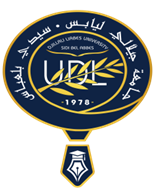- [FSNV-BIO] Théses de Master II
Permanent URI for this collection
Browse
Browsing - [FSNV-BIO] Théses de Master II by Author "BELGACEM Hanane"
Now showing 1 - 1 of 1
Results Per Page
Sort Options
- ItemEffet antimicrobien des extraits de Retama dasycarpa et Thymelaea hirusta récoltées de la région de Djelfa(2020) BELGACEM Hanane; Encadreur : Bousmaha-Marroki LeilaRésumé : ( Français ) Ce travail consiste à caractériser l’extrait végétal aqueux de Retama dasycarpa, et Thymelaea hirsuta plantes spontanées de Djelfa. Le matériel végétale est récolté séché et broyé en poudre afin d’augmenter le rendement en métabolites secondaires. Les résultats de rendement d’extrait aqueux de Retama dasycarpa, et Thymelaea hirsuta sont de l’ordre 0,93% et 1,74% respectivement, ce qui indique que la Thymelaea hirsuta est plus rentable que Retama dasycarpa. Le screening phytochimique qui a révélé la présence des flavonoïdes, des tanins, et des saponines. Retama dasycarpa renferme également un faible taux de coumarine tandis que Thymelaea hirsuta s’est révélée exempte de cette famille de composés. L’évaluation de l’effet antimicrobien des extraits obtenues à partir de Retama dasycarpa, et Thymelaea hirsuta été envisagé dans cette étude. Les microorganismes ciblés étaient Pseudomonas aeruginosa et Staphylococcus aureus, deux espèces bactériennes pathogènes opportunistes. Cette partie n’a pas été réalisée par le fait de la crise sanitaire liée à la pandémie du Covid 19. Mots clés : Extraits végétaux, screening phytochimique, Retama dasycarpa, Thymelaea hirsuta, pouvoir antimicrobien, Pseudomonas aeruginosa, Staphylococcus aureus. Abstract : ( Anglais ) This work consists in characterizing the aqueous plant extract of Retama dasycarpa, and Thymelaea hirsuta spontaneous plants of Djelfa. The plant material is harvested, dried and ground into a powder to increase the yield of secondary metabolites. The aqueous extract yield results of Retama dasycarpa, and Thymelaea hirsuta are in the order of 0.93% and 1.74% respectively, indicating that Thymelaea hirsuta is more profitable than Retama dasycarpa. Phytochemical screening which revealed the presence of flavonoids, tannins, and saponins. Retama dasycarpa also contains a low level of coumarin while Thymelaea hirsuta has been shown to be free from this family of compounds. The evaluation of the antimicrobial effect of extracts obtained from Retama dasycarpa, and Thymelaea hirsuta was considered in this study. The target microorganisms were Pseudomonas aeruginosa and Staphylococcus aureus, two opportunistic pathogenic bacterial species. This part was not carried out due to the health crisis linked to the Covid 19 pandemic. Keywords: Plant extracts, phytochemical screening, Retama dasycarpa, Thymelaea hirsuta, antimicrobial power, Pseudomonas aeruginosa, Staphylococcus aureus.
